A couple of weeks ago we hosted yet another insightful webinar. This time we talked about all things Facebook Ads and how to boost your ROI. For all of you that didn’t get a chance to join us at the live webinar, we do have a recording available, as well as the presentation slides. So if you’d like to watch the full recording, simply hit the button below.
And for those of you who prefer reading blog posts over watching videos – this one’s just for you.
1. Optimize for the correct actions
When creating your Facebook Ad campaign, the first thing you want to make sure of is to choose the right campaign objective.
Choosing the right campaign objective is extremely important since you want Facebook to know what your primary business goal is. For e-commerce businesses, that’s usually generating purchases and increasing sales. Therefore, you should always choose “Sales” as your campaign objective.
⚠️ Note: Once you’ve chosen your campaign objective you can’t change it anymore. So if you’re running a campaign that doesn’t optimize for sales, make sure to create a new one.
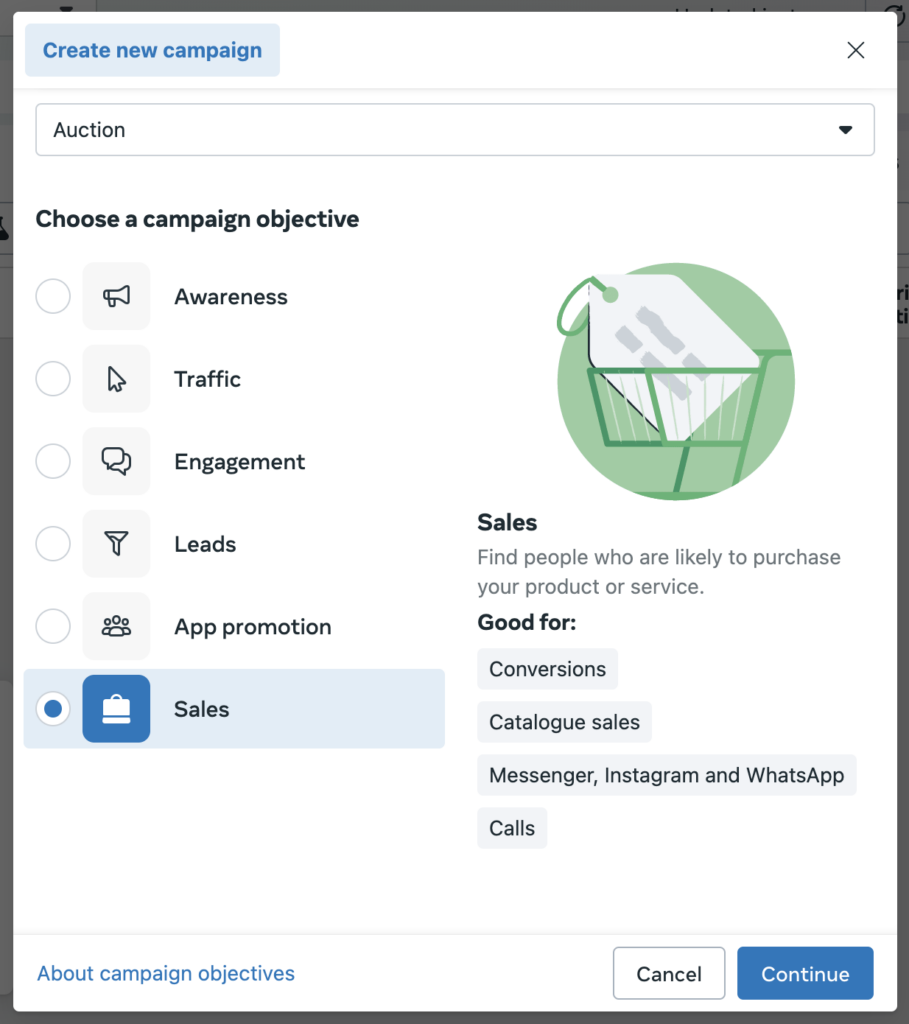
But that’s not all. After choosing your campaign objective, you also need to tell Facebook what do you want to optimize your ad sets for.
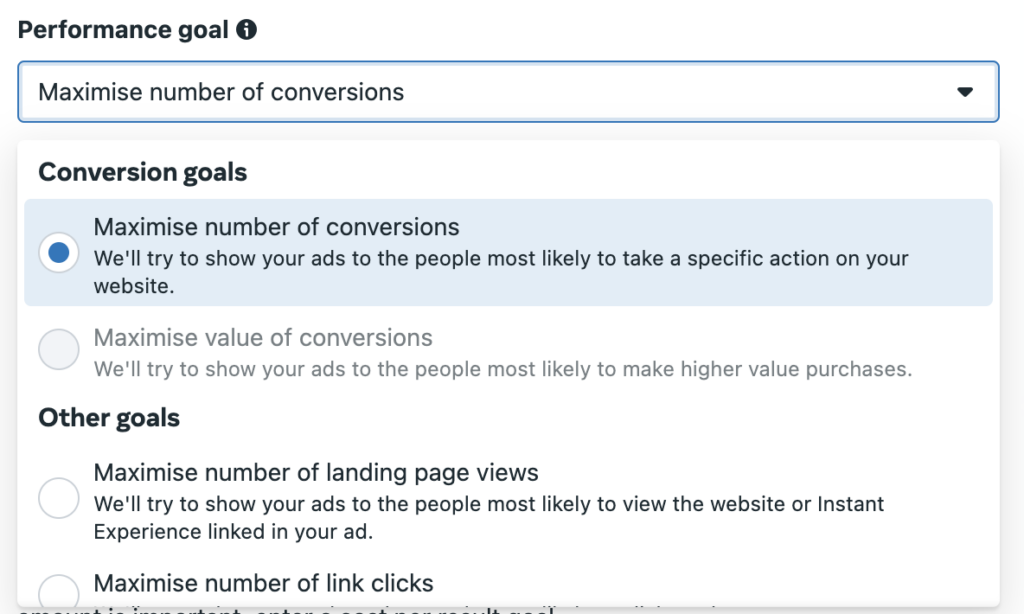
As you can see from the screenshot above, when optimizing your campaigns for conversions, Facebook also recommends that you optimize your ad sets to maximize the number of conversions.
Let’s quickly explain why we don’t recommend choosing any other optimization.
For example, when optimizing for landing page views, you’re basically telling Facebook to find people who are most likely to click on your ad and then visit your website.
But even if a lot of people land on your website that doesn’t necessarily mean they are going to purchase something.
Facebook gives you what you ask for. So if your goal is to generate as many purchases, what’s the point of using the landing page views optimization?
We tested landing page views vs. conversions many times on multiple ad accounts and we’ve always seen better results with the conversions optimization.
Looking at the key metrics below, you can see that when optimizing for conversions, the CAC was 90% lower, the CR was x13 higher and the bounce rate was also lower.

2. Use advantage+ placements
The second hack we want to mention is actually quite simple, but trust us, it makes a whole lot of a difference.
What we often notice is advertisers choosing manual placements over automatic ones, and therefore, miss out on many potential conversions.
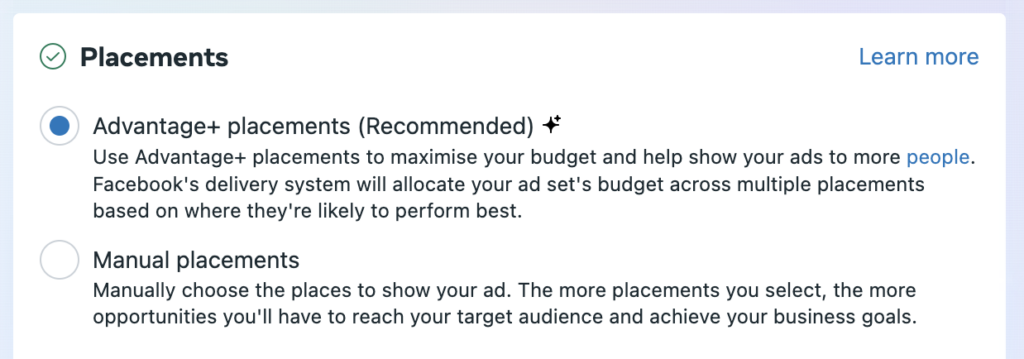
Advantage+ placements enable you to get the best possible results across all available placements. This means that Facebook will test out all the available placements and then allocate your budget across multiple placements, based on where they’re likely to perform best.
So if a certain placement is not performing well, the algorithm is going to focus on the opportunities across other available placements.
And as always, we’ve pulled some data from one of our a/b tests to show you why we always recommend using automatic placements.
As you can see from the table below, when using automatic placements the CAC decreased by 50%, while CPC decreased by 153%.
We’ve tested this out over and over again on multiple ad accounts, and we’ve always found automatic placements to be the clear winner. So if you’re still using manual placements, or you have been hesitant towards testing automatic placements, we highly suggest that you do.
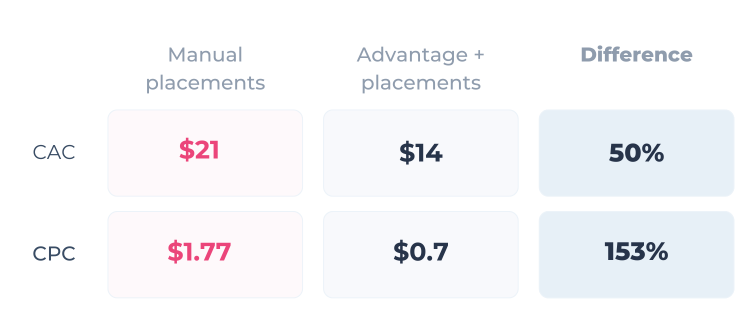
3. Target the correct audience
Audience targeting also plays a major role in your Facebook Ad campaigns.
Generally, with Facebook Ads, you want to have a very clear and distinguished audience funnel. At the top of the funnel is your cold, prospecting audience that includes people who aren’t familiar with your business or products in any way.
On the other hand, a retargeting audience is a lower-funnel audience that includes people who are familiar with your business and have been on your website but haven’t purchased yet.
If you’re familiar with all the available targeting options on Facebook, you know that you have three options to choose from:
- Lookalikes
- Interest targeting
- Broad targeting
In the past couple of years, lookalikes were considered best performers, but as of today, almost every Lebesgue customer uses broad targeting.
After testing multiple audiences on different ad accounts, we’ve found that the fewer restriction we put on the algorithm, the better is the performance in terms of customer acquisition cost (CAC), and conversion rate (CR).
So essentially, this means that by targeting a broad audience, you’re giving Facebook much more “room” to optimize and find people who are most likely to convert (purchase).
4. Use the best copy
If you’re struggling to write effective, high-converting ad copy, you’re absolutely going to love this next hack.
Recently we analyzed ad copies from over 4000 ads to determine which elements of ad copy work best for prospecting and retargeting.
For prospecting campaigns, we’ve found that using emojis, mentioning promotions and free shipping increases the ROAS.
On the flip side, you can see that using urgency and social proof decreases the ROAS, therefore you should avoid it when writing copy for your prospecting audience.
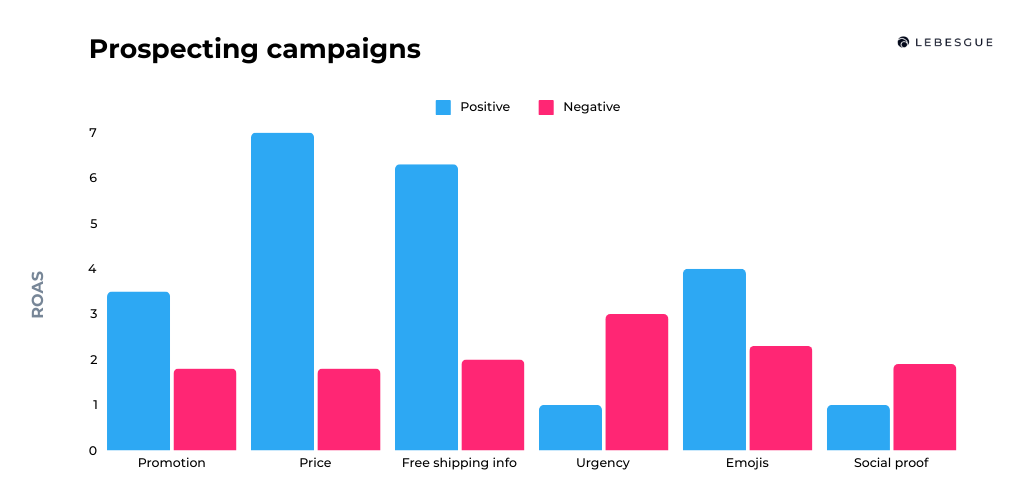
For remarketing campaigns, we’ve not only seen that using emojis and mentioning free shipping increases the ROAS but also using urgency and social proof.
You might be wondering how come that using urgency and social proof works for remarketing but not for prospecting?
Well, when you think of it, it actually makes sense. A cold audience that’s not familiar with your business yet is definitely not going to be interested in reading reviews or being “pushed” to purchase something.
On the flip side, a warmer, remarketing audience, is most likely going to convert on these ads since they have already been to your website and explored some of your products.
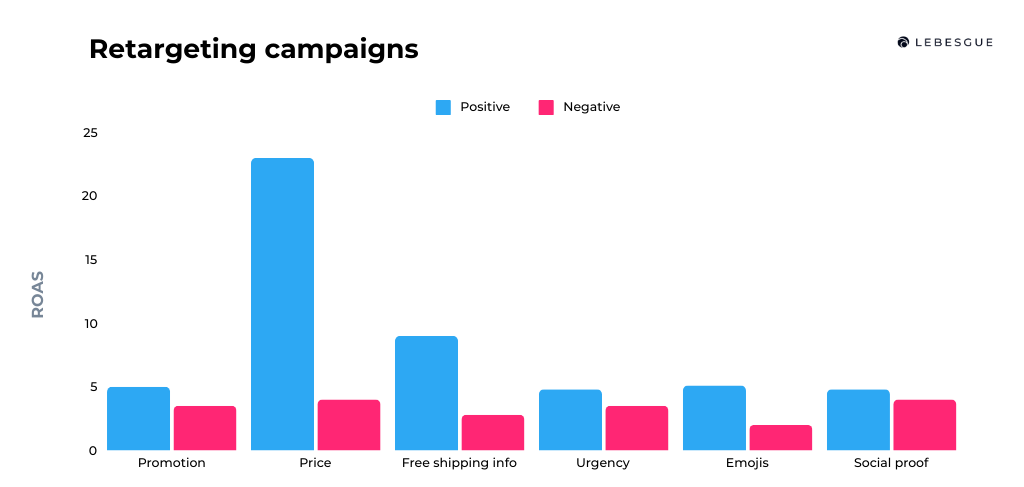
This analysis also proves how important it is to have a different approach and communication for your prospecting and retargeting audience.
5. Utilize those 5-star emojis
Have you ever considered adding emojis in your ad description?
Specifically, 5-star emojis. ⭐⭐⭐⭐⭐
Well, if you didn’t, we hope that you will now.
We decided to test three ad description variations to see if one of them would stand out. With the test completed, we didn’t see much of a difference in the CTR, but the CR and ROAS were significantly higher on ads with the 5-star emoji description.
So yeah, emojis really do work wonders, not only for your primary ad text but also for your ad description.

6. Don't use video ads
While we’re talking about ad copy, let’s see which creative we recommend using and why.
When it comes to choosing the creative format, a lot of advertisers tend to go for video ads.
Yes, videos are way more fun and engaging than static images, and you’re most likely going to achieve a higher click-through rate (CTR), but is that really your most important metric?
Well, the CTR is important, but there are way more important metrics you should be looking at, such as customer acquisition cost (CAC) and cost-per-mille (CPM).
So to answer your question, why we recommend using static images, let’s look at our a/b test results.
When testing this, all other variables in the ad sets and ads remained the same, so we could really understand the performance of these two creative formats.
With the test completed, we’ve seen that video ads not only had a significantly higher CPM but also CAC and CPC.
On top of that, the CR was also lower on video ads, so as you can see, using video ads is after all, not that beneficial.

7. Keep track of your competitors
Another simple, yet useful hack you shouldn’t ignore is to learn from your competitors.
Performing a competitive analysis is an essential step for every business that wants to stay updated with the market. The insights that you get from a competitive analysis can really shape and improve all aspects of your business.
We know that making an informative and detailed competitor analysis can be challenging, and that’s exactly why we decided to build our Competitor Analysis feature.
With the Competitor Analysis feature, you’ll be able to systematically analyze your competitors’ digital marketing efforts and identify their strengths and weaknesses that will give you insight into where you can further improve and enhance your strategy.
For example, you can use the feature to discover industry leaders, analyze their Facebook and Google ads, and see which keywords they’re bidding on. You can also view all of your competitors’ turned-off ads.
Don’t forget about email marketing. Lebesgue lets you see all the emails your competitors are sending to customers, providing insights into their email strategy.
If you’d like to give it a try, simply hit the button below.
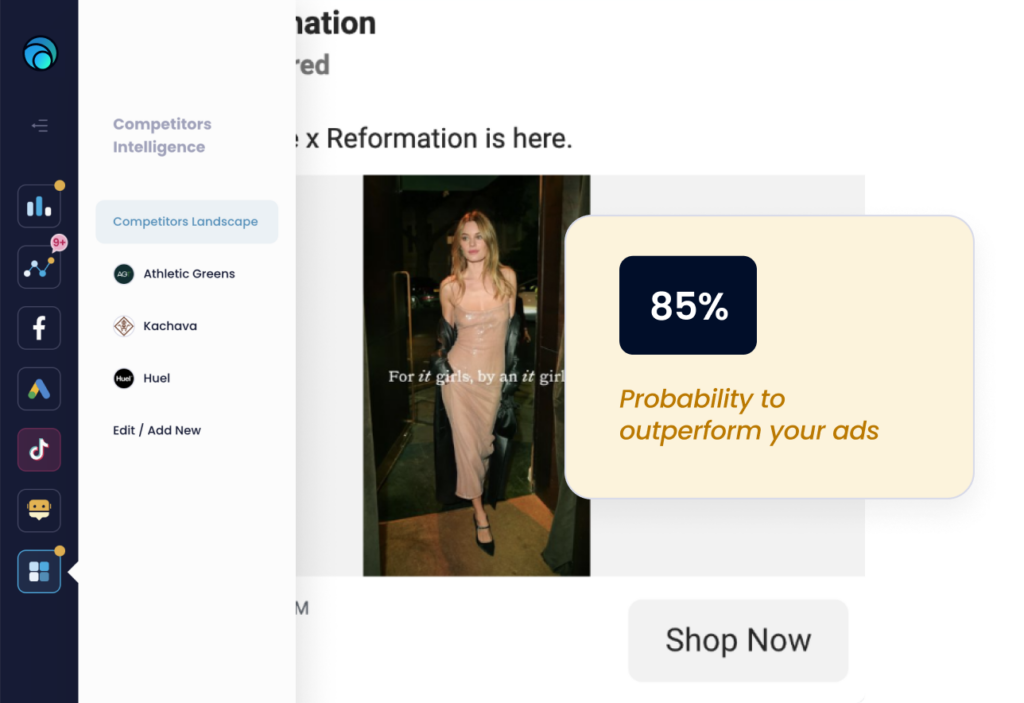
8. Use the conversion API
First off, let’s quickly explain what the conversion API is. The Conversion API is essentially a tool that allows you to measure the effectiveness of your ad campaigns and ultimately, improve your website tracking.
Even though the Facebook Pixel already helps you track your customers’ data, we do recommend also using the conversion API as it further improves your targeting, optimization, and measurement.
To connect the conversion API to your Shopify store, follow the steps below.
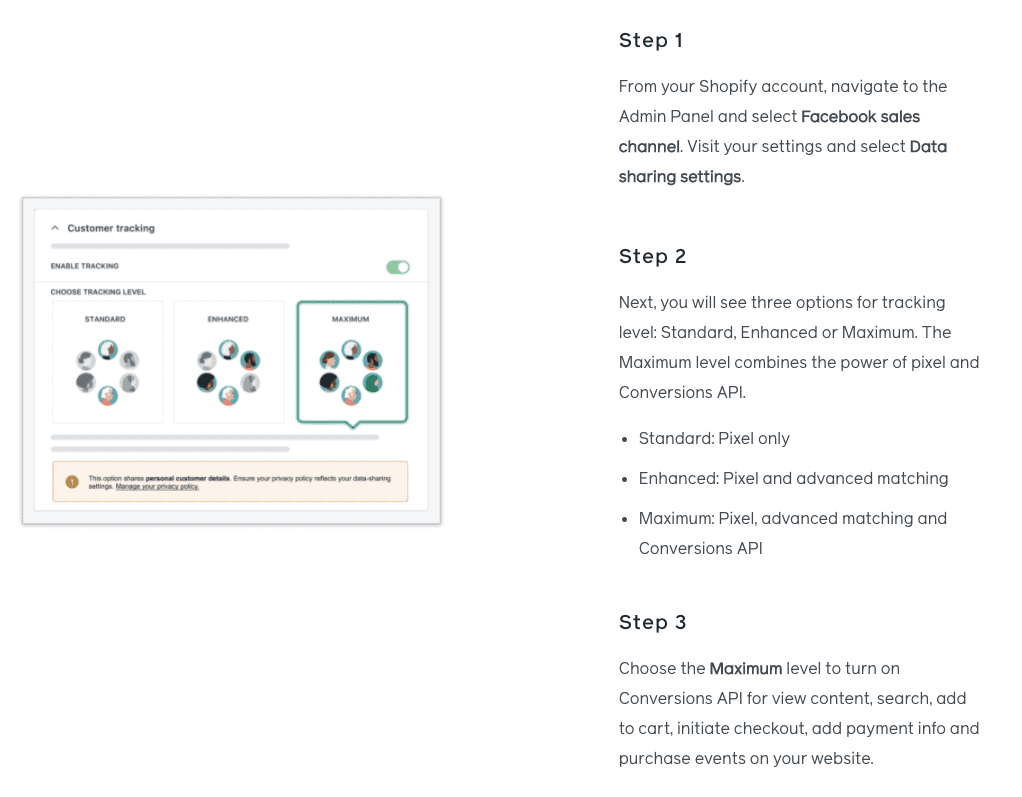
9. Ignore the learning phase myth
The last thing we’d like to advise you is to not worry about the Facebook Ads learning phase. Over the years, we heard numerous times advertisers say how it’s extremely important to exit the learning phase in order to achieve better results.
But is that really the case?
Surprisingly, as we can see from our a/b test results, ad sets that were still in the learning phase had a 10% lower CAC, along with a better CR and CPC.
So this just proves that, once you exit the learning phase, your CAC doesn’t magically become better – which is the exact opposite of what Facebook tells us.

Summing Up
Now that you know what are our top Facebook Ad hacks to boost your ROI, it’s time to put them to the test. Go through your ad campaigns and try to implement some of our tips. We guarantee you’ll see an improvement in your overall results.



